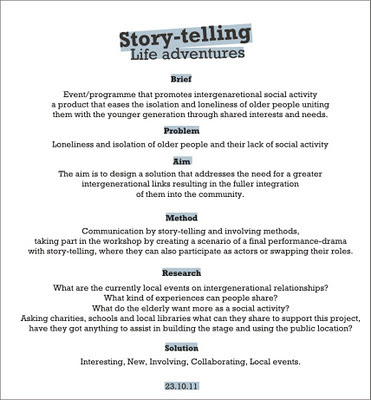I have tried to contact the organizations and charities which deal with Intergenerational relationships, the elderly and other generation people, sending them emails with questions about my project.
From some of them I still haven`t got any response, whilst some of them replied and either answered some of my questions or directed me to more competent people who can help or share experiences similar to my project.
I have started my project researching locally and tried to approach local and official authorities.
................................................................................................................................................
These are the questions directed to them, after explaining the project:
"The cycle of life, all generations sharing stories
I am working in a brief about researching the
possibilities of
creating an event or programme that will bring together
the
relationships between the young and elderly whilst promoting their
social activity.
I would like to organise a workshop in which different
(the elderly
and the youngsters) generation can communicate, talk,
tell stories and share experiences which would lead to
making a
scenario towards a drama performance as a final product
of their
social activity promotion.
The idea is to research the possibilities that they themselves create scenario and play
it in a
drama as a final product of the project."
1. What do you think about
the idea?
2. Would you be able to
assist and what would that be?
3. Would you be able to
provide us with a space for workshop and later performance?
4. What would be the best
timing to organise this event so they don’t clash with your other activities?
5. Would you be able to assist
with printing of promotion material, or direct us to any charity organisation that could assist?
...or if you could direct me to any charity organisation
which could be helpful for the above intent?
...................................................................................................................................................
I have started with a local library where they directed me to Royal Borough of Kensington and Chelsea, their reply was:
"The idea sounds fine and you may find HistoryTalk a useful contact as
they have organized intergenerational activities similar to this."
...they have given me some other links which I contacted via email.
Westway (community projects)
New Horizonts ( a multi-activity centre for older people) replied to me and directed to another contact...
"...thank you for
getting in touch, I would recommend you contact B. L. at Age Concern
Kensington and Chelsea, he deals with intergenerational projects and has
done similar projects and has connections with schools etc and is best
placed to help with this. I'm sure he would be happy to answer any
questions you have. However if your only looking
for a couple of sessions then we could provide a room during term break
for a workshop or performance and we could publicise through usual
channels, but we couldn't contribute towards payments for printing or
other promotion."
They provided me with contact-email for Age Concern to whom I have written, sent them the questions from questionnaire and asked for advice for project; I am waiting for a response.
I have to mention that during my interviews in the streets, I passed Westway-citizen advice center and started doing my interview with a woman at the reception and she firstly gave me very hopeful answers till the end when she signed her personal name regreting to put her company name instead (she did not accept to take picture for records as well) and her answers were like...
"I think that this is a very good idea,
I would have been assisting younger`s as a mentor,
Hypothetically speaking (if it happens) the organisation would be able to offer a space...all the evenings,
One of her answers were that if it happens we can assist with printing of promotion material..."...nevertheless I am trying too contact them via email,


















